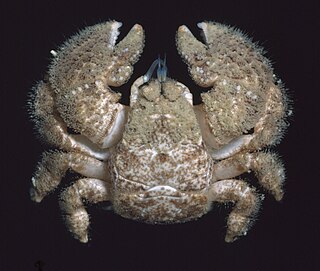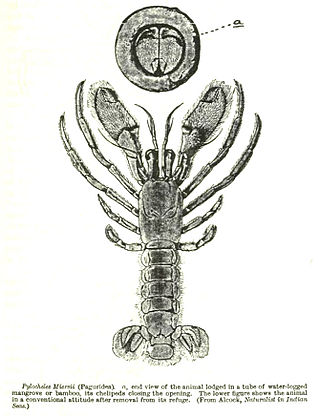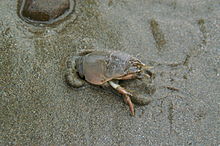
Ovalipes ocellatus, known as the lady crab, is a species of crab from eastern North America. Other names for it include the leopard crab or Atlantic leopard crab due to the leopard-like rosette patterns on its shell, the calico crab, or ocellated crab. It has a shell 3 in (7.6 cm) long and only slightly wider, which is covered in clusters of purple spots. It occurs from Canada to Georgia, and lives mainly on molluscs, such as the Atlantic surf clam.

Anomura is a group of decapod crustaceans, including hermit crabs and others. Although the names of many anomurans include the word crab, all true crabs are in the sister group to the Anomura, the Brachyura.

Porcelain crabs are decapod crustaceans in the widespread family Porcellanidae, which superficially resemble true crabs. They have flattened bodies as an adaptation for living in rock crevices. They are delicate, readily losing limbs when attacked, and use their large claws for maintaining territories. They first appeared in the Tithonian age of the Late Jurassic epoch, 145–152 million years ago.

The halloween hermit crab, also known as the striped hermit crab or orange-legged hermit crab, is a brightly colored aquatic hermit crab of the family Diogenidae. Besides its ability to routinely clean algae in aquaria, the halloween hermit crab's festive striped coloration also appeals to enthusiasts; it is considered the most brightly colored hermit crab in normal aquarium use.

Portunidae is a family of crabs which contains the swimming crabs. Its members include many well-known shoreline crabs, such as the blue crab and velvet crab. Two genera in the family are contrastingly named Scylla and Charybdis; the former contains the economically important species black crab and Scylla paramamosain.

The hairy stone crab is a crab-like anomuran crustacean that lives in the littoral zone of southern Australia from Bunbury, Western Australia, to the Bass Strait. It is the only species in the family Lomisidae. It is 1.5–2.5 cm (0.6–1.0 in) wide, slow-moving, and covered in brown hair which camouflages it against the rocks upon which it lives.

Hippoidea is a superfamily of decapod crustaceans known as mole crabs or sand crabs.

The coconut crab is a terrestrial species of giant hermit crab, and is also known as the robber crab or palm thief. It is the largest terrestrial arthropod known, with a weight of up to 4.1 kg (9 lb). The distance from the tip of one leg to the tip of another can be as wide as 1 m. It is found on islands across the Indian and Pacific Oceans, as far east as the Gambier Islands, Pitcairn Islands and Caroline Island and as far west as Zanzibar. While its range broadly shadows the distribution of the coconut palm, the coconut crab has been extirpated from most areas with a significant human population such as mainland Australia and Madagascar.

Albuneidae is a little-known family of specialized burrowing sand crabs. There are 50 extant species as well as nine fossil species that have been described. Fossil specimens have been described from the Cretaceous, Miocene and Oligocene.

The Pylochelidae are a family of hermit crabs. Its members are commonly called the 'symmetrical hermit crabs'. They live in all the world's oceans, except the Arctic and the Antarctic, at depths of 2,000 m (6,600 ft). Due to their cryptic nature and relative scarcity, only around 60 specimens had been collected before 1987, when a monograph was published detailing a further 400.

Amarinus lacustris is a species of freshwater crab from Australia, New Zealand and nearby islands, where it lives in water of various salinities. It grows up to 10 mm (0.4 in) wide, with an H-shaped groove on its back. It is an omnivore and is eaten by crayfish and fish. It was first discovered in Lake Pupuke, near Auckland, and is the only freshwater crab in New Zealand.

Pagurus sinuatus is a large species of hermit crab found in Australia and the Kermadec Islands. It is red or orange in colour with coloured bands on the legs and patches on the body.
The Pylojacquesidae are a small family of hermit crabs, comprising only two monotypic genera. The family was erected in 2001, after two specimens at Museum für Naturkunde at the Humboldt University of Berlin were recognised as being quite distinct from other described hermit crabs. The family members differ from other hermit crabs in that their mandibles are chitinous and toothed.

Emerita analoga, the Pacific sand crab, Pacific mole crab or coldwater mole crab, is a species of small, sand-burrowing decapod crustacean found living in the sand along the temperate western coasts of North and South America. It is found on exposed sandy beaches in the swash region of the intertidal zone.

The Panopeidae are a family containing 26 genera of morphologically similar crabs, often known as "mud crabs". Their centers of diversity are the Atlantic Ocean and eastern Pacific Ocean.

Blepharipodidae is a family of sand crabs (Hippoidea), comprising the two genera Blepharipoda and Lophomastix. They are distinguished from the other families in the superfamily Hippoidea by the form of the gills, which are trichobranchiate (filamentous) in Blepharipodidae, but phyllobranchiate (lamellar) in Albuneidae and Hippidae. Fossils belonging to the genus Lophomastix have been found in rocks dating back to the Eocene.
Emerita rathbunae is a species of "mole crabs" or "sand crabs" in the genus Emerita that lives along the tropical Pacific coasts of the Americas.

Albunea carabus is a rare species of "sand crab" or "mole crab" in the family Albuneidae. It lives in shallow, turbulent waters in sandy areas of the tropical eastern Atlantic Ocean and the Mediterranean Sea.

Hippa adactyla is a species of small, sand-burrowing decapod crustacean found living along the coasts of Indo-West Pacific waters. It is found on exposed sandy beaches in the swash region of the intertidal zone.

Emerita talpoida, known generally as the Atlantic mole crab or Atlantic sand crab, is a species of mole crab in the family Hippidae. It is found in the western Atlantic Ocean and Mexico along the shoreline.

















